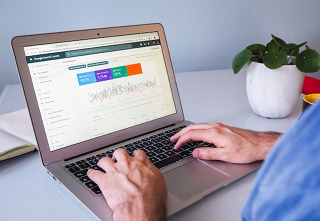Universal Analytics properties will stop processing new hits on 1st July 2023
Day(s)
:
Hour(s)
:
Minute(s)
:
Second(s)
In this guide, we will go through the benefits and capabilities of GA4, so that you are prepared to make the change. If you need help switching to Google Analytics 4, reach out to our helpful team of analytics experts.
What is GA4?
GA4 stands for Google Analytics 4. Like Universal Analytics, GA4 collects data for websites and apps, allowing for performance measurement and analysis, and promises a better understanding of customer journeys, focusing more on event-based data than its predecessor and increased privacy controls.
As of July 2023, new data will only be processed through Google Analytics 4, so while historic Universal Analytics reports will still be available for a short period of time, ensuring GA4 is set up and working correctly by this date is imperative for a seamless transition.
How is GA4 Different from UA3?
One of the most noticeable differences between Universal Analytics and GA4 is the way in which data is reported. Whilst Universal Analytics focus on session-based data, GA4 is designed to report events. This can be tricky to initially get to grips with, but offers greater insight into the user experience when configured correctly.
In Universal Analytics, visits to a website or app are segmented by devices or platform sessions. GA4 allows for more accurate tracking of users across different platforms (for example, if a user visits on their desktop, then returns on their mobile device), as well as both websites and apps by using event-driven data.
GA4 also utilises new user-centric metrics to help predict customer actions, such as revamping “bounce rate” into “engagement rate” and offering pre-configured events to help you understand how audiences are interacting with your website.
Additionally, GA4 offers improvements in user privacy. With more regulation on the collection and sharing of data than ever before, it falls to Analytics to fill in the gaps, providing insight to marketers without compromising on safety. To achieve this, fundamental changes to the way Google Analytics works were required. GA4 gives more control to website owners over what data is collected, so current and upcoming privacy laws can be fully adhered to as they change and develop.
Will GA4 Impact my Ad Campaigns?
With GA4’s user journey improvements, marketers are offered greater insight than before into the success of their campaigns. For example, a user may click your ad on their mobile, browse the site, and return on their desktop later to finalise the purchase and convert. Using Universal Analytics’ session-based measurements, this would be difficult to pick up on and track, however, GA4 allows website owners to stitch these visits together. From here, marketers will have greater insight into their return on ad spend, and be able to optimise campaigns more efficiently.
Switching to GA4 from Universal Analytics
Adding GA4 to a site that is already collecting data with Universal Analytics is a relatively simple process. When creating a GA4 property within your account, the GA4 setup assistant should guide you through the process and help you ensure data is being tracked correctly. Until July 2023, you can collect data in both Universal Analytics and GA4.
For more information, Google Support has a number of articles advising on the best way to set up GA4.
Setting Up Goals in GA4
In Universal Analytics, setting up goals could be a difficult process, taking up time and developer resources if you have little knowledge of editing code. In GA4, Gaols are rebranded into conversions. Whilst some key goals, such as form submissions, may need configuring, GA4 automatically creates a number of events for measuring, such as clicks, scrolling, and downloads. Additionally, events created by the user require far less coding know-how, allowing marketers to go into more detail with what they want to measure and creating new conversion points with far less effort than before.
Additionally, setting specific events as conversions is easy within GA4 and more complicated conversion paths can be easily tracked using Google Tag Manager.
Reporting in GA4
Users new to GA4 may encounter difficulties coming to grips with its reporting structure. This is understandable as there is not a like-for-like function in both Universal Analytics and GA4. This is because of the changes in what each generation of analytics measures, from session-based to user journeys. It is worth taking some time to familiarise yourself with the built-in analysis hub for templated charts, allowing marketers to build their own reports on the metrics that matter most to them. For some tips on building your GA4 reports, check out our GA4 tips.
With the end of Universal Analytics getting closer, switching to GA4 in the next few months needs to be the top priority for all website managers and marketers.
For more information on getting started with GA4, feel free to get in touch with Bespoke Digital for support from our in-house experts.

